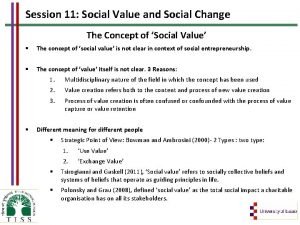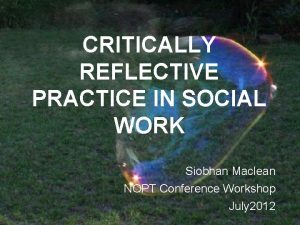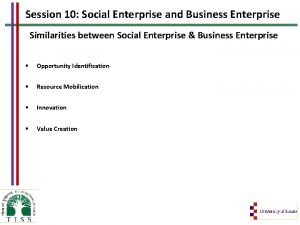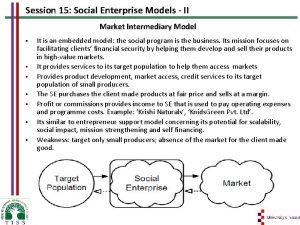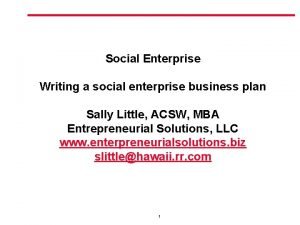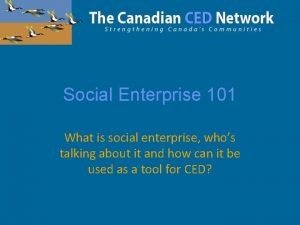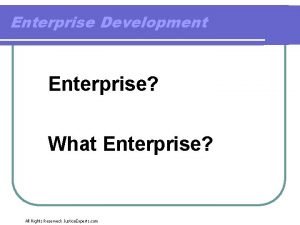Session 14 Social Enterprise Models I Social Enterprise














- Slides: 14

Session 14: Social Enterprise Models - I Social Enterprise § A social enterprise is an organization created by social entrepreneur to solve social problem and create social value. § Social enterprises use entrepreneurship, innovation and market approaches to create social value and change § A social enterprise may be structured as a department, program or profit centre within a non-profit and lack legal definition from its parent organization (Alter, 2006). § It may also be a subsidiary of its non-profit parent, registered either as a for-profit or non-profit. Many organizations use a mix of different structures simultaneously. § There is no uniform legal framework available across the globe.

Session 14: Social Enterprise Models - I Social Enterprise Classification § Social Enterprise has Dual Objectives: 1. Social Impact/Mission (drives Social Value Creation) 2. Financial Need and market Opportunities (drives Economic Value Creation) § Money and mission are combined in the Social Enterprise. § Purpose determines whether a practitioner engages in SE as a programme strategy or a financial strategy.

Session 14: Social Enterprise Models - I Social Enterprise Classification based on Mission Orientation 1. Mission Centric Social Enterprise 2. Mission Related Social Enterprise 3. Social Enterprise unrelated to Mission

Session 14: Social Enterprise Models - I Mission Centric Social Enterprise § Business activities are central to the parent organisation’s social mission. § These SE are created for the purpose of advancing the mission using a self-financing model. § Examples: Dairy Cooperative, Agricultural Cooperative etc.

Session 14: Social Enterprise Models - I Mission Related Social Enterprise § Business activities are related to the organization’s mission or social services. § SE have synergistic properties, creating social value for programmes and generating income to subsidize programme-costs. § Commercialization of Social Services is a common form of mission-related social enterprise. § Mission Expansion is another type of such enterprises. § Examples: Dignity Foundation– working for senior citizen etc.

Session 14: Social Enterprise Models - I Social Enterprise Unrelated to Mission § Not intended to advance the mission other than organization’s social programmes and operating costs. income generation for § Business activities may have a social bent, operate in an industry relate to the notfor-profit parent organization’s services or sector. § Profit potential is the motivation for creating such organizations.

Session 14: Social Enterprise Models - I Social Enterprise Classification based on the Level of Integration between Social Programmes and Business Activities 1. Embedded Social Enterprise 2. Integrated Social Enterprise 3. External Social Enterprise

Session 14: Social Enterprise Models - I Embedded Social Enterprise § The business activities and social programmes are synonymous. The relationship between these two aspects of ESE is comprehensive. § The enterprise activities are ‘embedded’ within the organization's operations and social programs, and are central to its mission. § The main reason for creating ESE is to accomplish their organisation’s mission. § The not-for-profit target population is a recipient of the enterprise, either as the target market, a direct beneficiary, owner or employee. § Social programmes are self financed through enterprise revenues. § ESE is a sustainable business strategy. Embedded Social Enterprise

Session 14: Social Enterprise Models - I Integrated Social Enterprise § § § Social programs overlap with business activities, often sharing costs and organizational assets as the foundation for its business. The enterprise activities are ‘integrated’ with the Integrated Social Enterprise organization’s operations. Objective of creating not-for-profit ISE as funding mechanism is to support their operations and social activities or, to expand or enhance the org’s social mission. The latter may be achieved by commercializing social service to new fee-paying market or by providing new services to existing clients. In ISE not-for-profit client benefits from investments made in social programmes vis-à-vis earned income. However he may or may not be involved in enterprise’s operation. There is a synergy between the business activity and the social programmes. It is adding value–financial and social– to one another.

Session 14: Social Enterprise Models - I External Social Enterprise § § § § Social programs are distinct from business activities. The enterprise activities are external from the organisation’s operations and programmes, but support its social programs through supplementary financing. Nonprofits create external social enterprises to fund their social services and/or operating costs. Mission relevance and the pursuit of social benefit are not prerequisites of business activities The not-for-profit client is indirect beneficiary of revenue and indirectly in any operational aspect of the ESE. These enterprises may & may not benefit from leveraging, cost sharing or programme synergies. The relationship between business and social programmes is supportive. However, there is unrestricted funding to the not-for-profit parent organizations External Social Enterprise

Session 14: Social Enterprise Models - I Fundamental Operational Models Based on Practice-to-theory Approach. § Entrepreneur Support Model § Market Intermediary Model § Employment Model § Fee-for-Service Model § Service Subsidisation Model § Market Linkage Model § Organisational Support Model

Session 14: Social Enterprise Models - I Legend for interpreting Social Enterprise Diagram

Session 14: Social Enterprise Models - I Entrepreneur Support Model § § § § It is an Embedded Model: the social program is the business, its mission centers on facilitating the financial security of its clients by supporting their entrepreneurial activities. (Mission Centric Model) It achieves financial self sufficiency through the sales of its services to clients, and uses this income to cover costs associated with delivering entrepreneur support services as well as the business' operating expenses. It sells business support and financial services to self employed individuals (most often poor or disadvantaged people). Its strength- serves larger number of clients. Extra income is used for auxiliary services like health education, insurance etc. Example: Microfinance- Annapurna, SEWA The problem of this model is that its application is narrow and limited to economic development. Viability is difficult to achieve without scale as all the clients are poor entrepreneur.

Session 14: Social Enterprise Models - I References: § Alter, S. K. (2006). Social enterprise models and their mission and money relationships. In A. Nicholls (Ed. ), Social entrepreneurship: New models of sustainable change (pp. 205 -232). New York: OXFORD University Press.
 Enterprise session border controller
Enterprise session border controller Semi modals
Semi modals What is enterprise architecture maturity model
What is enterprise architecture maturity model Define social change
Define social change Putting the enterprise into the enterprise system
Putting the enterprise into the enterprise system Enterprise
Enterprise Social service delivery models
Social service delivery models Models of casework
Models of casework Remedial model social work
Remedial model social work Models of appraisal in health and social care
Models of appraisal in health and social care Social welfare models
Social welfare models Rachel rayner model of reflection
Rachel rayner model of reflection Models of social work
Models of social work Social thinking social influence social relations
Social thinking social influence social relations Social thinking social influence social relations
Social thinking social influence social relations



